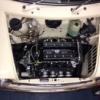With the aim being to switch from an inertia starter to a pre-engaged, there are two ways of doing this, switch to a verto, or obtain a non-verto flywheel with a pre-engaged starter ring.
The only new ones available are of the lightened variety..... Shame :grin: !!
But anyway... Why not a verto I hear you say, and if you ever wondered.. what's the difference between the two....
Well apart from the exterior differences, i.e. the clutch slave cylinder is in different places, pre-verto it is located on the top of the flywheel housing with a long arm, whereas on the verto it located on the side of bell housing with a short arm, the internal differences are very noticeable, and quite simply work in completely different methods.
Both styles are basically made up of four components, the flywheel, diaphragm, pressure plate and clutch plate.
So, the verto clutch is pictured below, front and back.

On the front of the clutch is the diaphragm, but in the verto, is joined to the pressure plate as one unit. This is also the part which is connected to the crank shaft ( again different in the verto )

The other parts of the unit are the flywheel and clutch plate

The flywheel is connected to the sprung part of the diaphragm and the clutch plate is sandwiched between the two.
In a verto clutch it is the flywheel and diaphragm which is pushed away from the pressure plate ( the inner part of the diaphragm which is connected to the crank ) when the clutch is disengaged.
So what about the non verto.
The non verto, IMO, is much simpler and a lot easier to comprehend. Again it is made up of the four basic components. With the flywheel playing the main supporting role, and the part which is attached to the crank.

On the front is attached the diaphragm, and on the back, the pressure plate. These two are again connected, but by bolts through the flywheel.
With the diaphragm and pressure plates separated, you can see the round spring, which provides the ‘pinch’ on the clutch and the friction surface on the pressure plate.

likewise the friction surface on the flywheel and clutch plate.

How this works is, the flywheel is connected to the crank, and as you disengage the clutch the diaphragm is pressed which pushes the pressure plate away from the flywheel. Basically the opposite thing to the verto.
Question: Which is better ?
Answer: Depends what you are doing….
If you want a smooth town run-a-round to do the shopping, then the verto is the clutch, It is designed for the everyday car, and the springs in the clutch plate soften out the engagement, does not need adjusting and will last as long as your gearbox and engine, or there about.
But, if you want to play looney tunes with your engine, then you’re really going to want to be on a pre verto. The reason for this is two fold, the different diaphragm’s and clutch compounds available to you. When you hear mention of an Orange or Grey diaphragm, the pressure of the spring is being discussed, and Orange ( Fast Road) is stronger than standard, and Grey ( Race ) is stronger than Orange, and the stronger the spring the stronger the pinch which is applied to the clutch plate. Clutch plates also can be altered to higher friction compounds and also to what are called sintered plates, which provide very little bite before fully engaged, quite simply on or off.
Question: What about lightening?
Answer: This has nothing to do with thunderbolts!
I’ve heard it said that taking a pound of the flywheel is like removing 100 pounds from the car. Therefore the more weight you can remove from this section of the revolving parts of an engine the better.
A Verto clutch in it’s standard form weighs in at about 10.5 kg’s, 23lb’s. most of that weight is split fairly evenly between the flywheel (5.5kg) and pressure plate/diaphragm (4.1kg), Unfortunately this means there is very little which can be removed from either before the structural integrity of the unit comes into question. The most I’ve seen is a 1.5kg reduction.
On a non-verto, with an overall standard weight similar to that of the verto, there is much more to be gained. Basically the majority of the weight is in the flywheel, and over time with competition use etc. The weight of the flywheel has been reduced by nearly 50% in the ‘ultralight’ flywheels to 3.8kg. A similar weight loss can also be achieved in the pressure plate, saving another kilo.
With a total weight loss of almost 5kg ( 10lbs ), this outstrips the verto hands down.
An Ultralight flywheel. Just too dam pretty to hide away in the engine.

And talk about slimmers world, Standard top, Ultralight bottom.



















